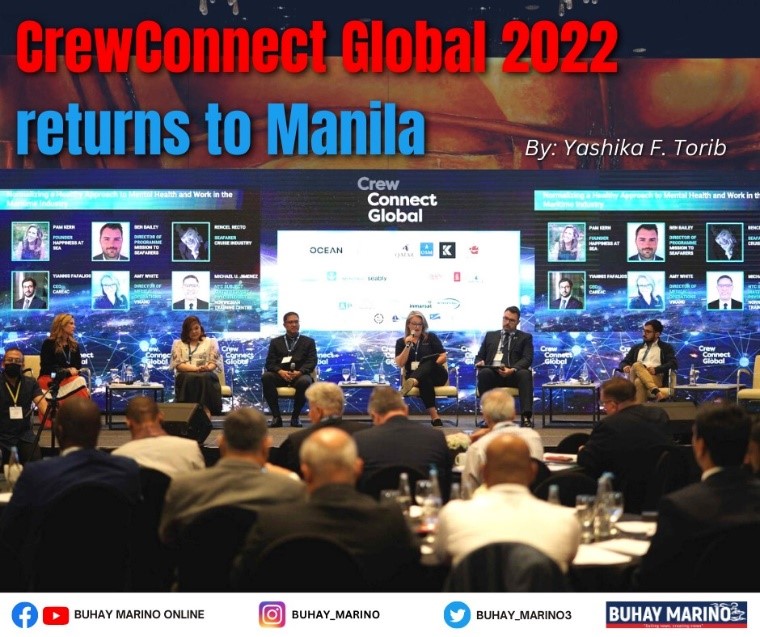CrewConnect Global 2022 returns to Manila

As posted by Buhay Marino Online on October 30, 2022
CrewConnect Global, the biggest manning event in the world, has returned to Manila featuring some of the most trending issues in the maritime industry discussed by the biggest names in the Philippine and global maritime sector.
The three-day event was slated last November 22 to 24 at the Sofitel Philippine Plaza, Manila.
CrewConnect Global is a flagship event in the maritime calendar, connecting the global crewing community to inform and inspire change in sustainability, crew management, training and safety, and seafarer well-being.
This year, the event focused “Journey to Net-Zero”, an industry effort to achieve net zero carbon emissions by 2050 and the right levels of training this entail for seafarer.
It also addressed the shortage of skilled seafarers exacerbated by the conflict in Ukraine, sub-par training programs, and the issuance of fraudulent certificates; and Training and Safety in a time when technology is rapidly changing the face of training delivery from online to virtual reality.
The delegates and speakers comprised of veteran maritime professionals around the world to include leaders from key maritime organizations such as International Chamber of Shipping, World Maritime University, and United Nations Global Compact. It also includes chief executives from major shipping and manning companies in the Philippines.
Among the Filipino speakers include Secretary of Transportation Jaime Bautista, PTC Group CEO and Filipino Shipowners Association President Gerardo Borromeo, PTC senior vice president of cruise operations Karen Avelino, and Dohle Seafront Crewing President Atty. Iris Baguilat.
The conference is complemented with an exposition hall, an awards ceremony, and a gala dinner to ensure that networking is at the heart of the event.
Journey to Net Zero
The maritime industry is under pressure to achieve net zero carbon emissions by 2050, and whilst shipping operators are taking different approaches, it is becoming clear that the industry must move fast beyond temporary fixes and adopt longer term strategies. This includes the use of alternative or next-generation fuels, LNG, ammonia, or hydrogen.
Such trend equates to new trainings for seafarers. It was noted during the conference that it is crucial for the crew to have access to the right levels of training to acquire the necessary competencies to ensure cargo, vessel and life are safe at sea.
In Japan, Mitsui O.S.K. Lines, Ltd. (Mol), one of the largest shipping companies in the world, has already begun with its zero-carbon emissions development. Recently, it launched a study on the development of a large ammonia carrier, fue-ammonia carriers suitable for domestic thermal power plants, and a fuel-ammonia transportation and receiving systems. It also studied the installation and operating propulsion engines that use ammonia as ship fuel.
Crew Supply Shortage
Crew shortages and the growing irregularities continue to provide challenges to the shipping sector. The well-documented shortage of skilled seafarers has since been exacerbated by the conflict in Ukraine.
The rise of sub-par training programs and the issuing of fraudulent certificates were noted to further aggravate the current crewing shortage. In response to these challenges, flag states are engaging in solutions to prevent and alleviate the looming crew shortage, as well there are various new and promising crew management solutions, designed to make it easier and safer to deploy crew and cater to their needs.
In an open forum, Avelino affirmed that while there is enough pool of qualified crew especially for international cruise ships, only a few are willing to return to sea. Among the cited reasons are the trauma caused by the pandemic, the reluctance to return back to sea after establishing a business ashore, and the preference to be at close proximity with loved ones.
To address the gap, the Philippine manning industry initiated moves to attract crew to return to ships.
“We utilized the social media to show the best of working with the cruise sector, the excitement, and the attractive benefits. We have also looked after the welfare of our crew who were repatriated during the pandemic. We supervised their airport transfers, accommodation set ups, food, and livelihood,” Avelino shared.
Training and Safety
Technology is rapidly advancing and with it, training delivery.
It is apparent that more training is now being delivered online, through e-learning and assessment, virtual reality (VR), or simulators. There is a concern, however,as to whether online learning can replace the competency levels produced by face-to-face training.
Guest speakers opined that the industry must strike the right balance between in-person and e-learning to optimize and not to affect standards. The need to update the Standards of Training, Certification, and Watchkeeping (STCW) was also raised.
It was likewise mentioned that while automated ships, digitized operations, gamified learning, and virtual reality are already here, the future of the maritime industry still relies on the human element.
“In Sri Lanka, we believe that everything should [still] be in class rooms because we are also training them for leadership skills, teaching them life at sea,” says Thomas Kriwat, global key account director of Kadmos.
“Parts of the industry has embraced e-learning. Shipping companies are for it due to its efficiency. However, class room instructions still offer more time on practical trainings,” says Thomas Lindberg, global head of sales and support of Seably.
Meanwhile, Jay Babera, vice president of OSM Shipping Services, observed that the mode of learning should depend on the trainee.
“It depends on the needs of the learner. For the younger seafarers and cadets, they might prefer gamified learning, while the older seafarers are into face-to-face learning. Blended is learning is good as long as seafarers understand why they are doing it,” he said. (𝐘𝐅𝐓)
